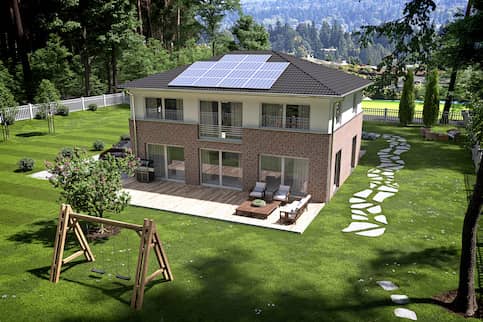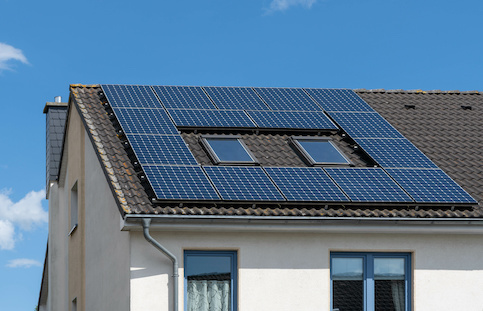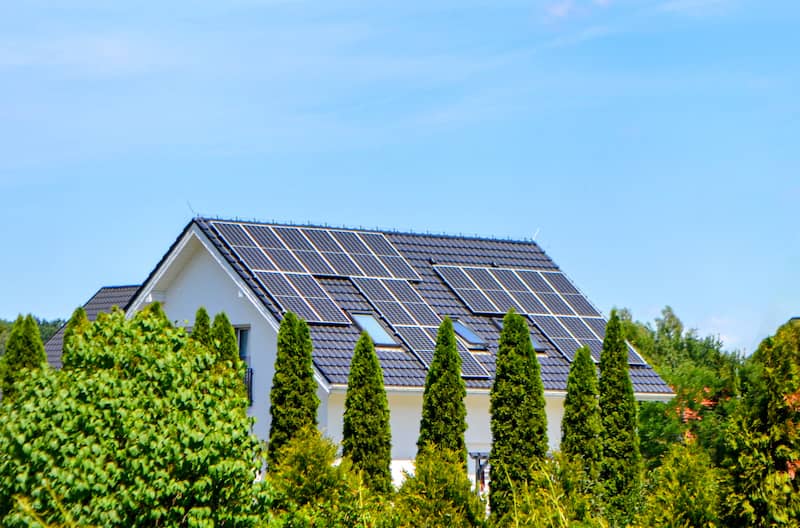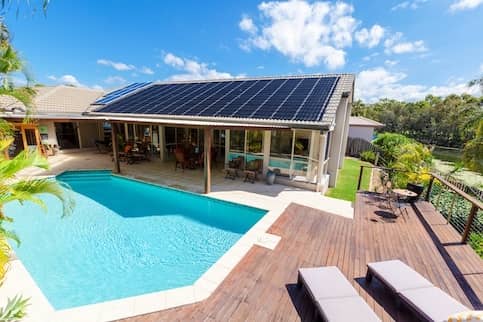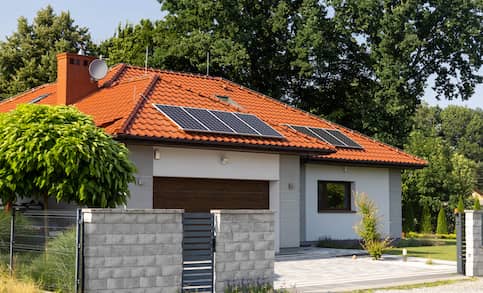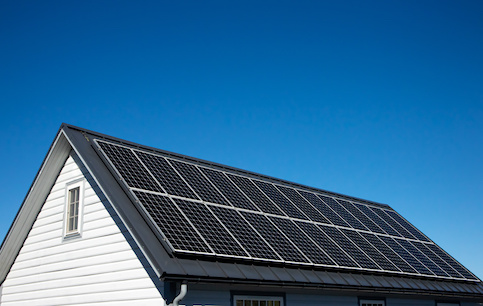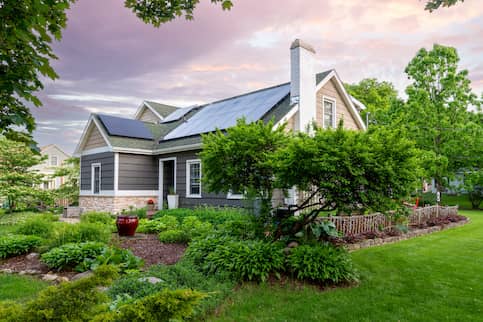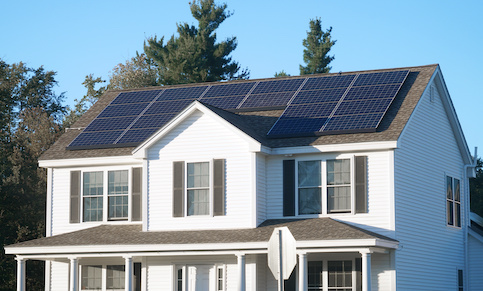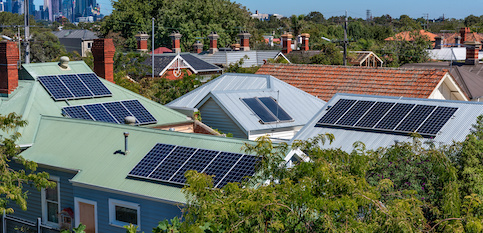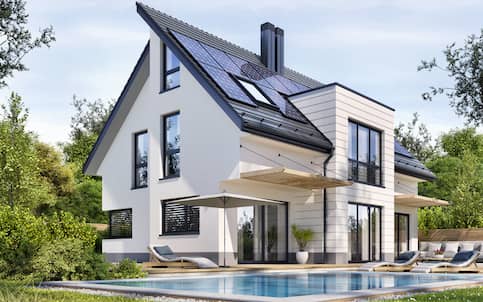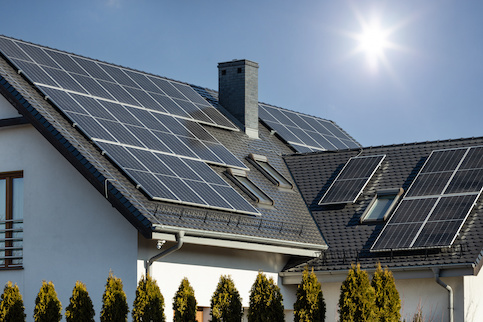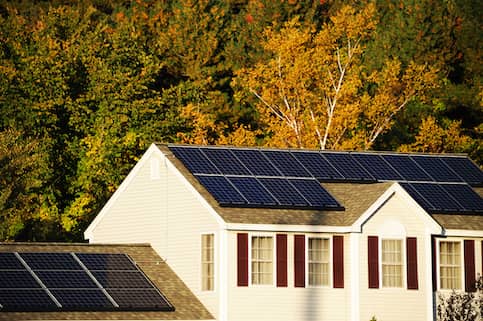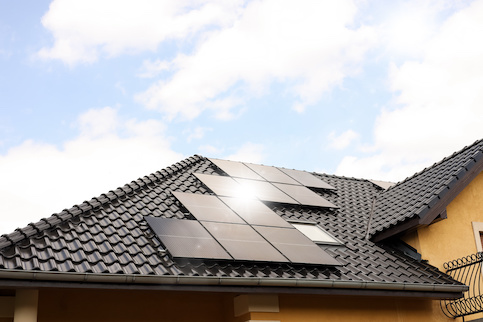More homeowners than ever are considering a move to solar power in an effort to cut down on energy costs and reduce their carbon footprint. Rooftop or pole-mounted solar panels capture energy from the sun’s rays and convert it into useful electricity that can power all, or at least some, of their home’s electric-powered appliances. Even home heating and air conditioning can be powered by solar energy. This article will discuss the economics of home solar power systems.
Find A Mortgage Today and Lock In Your Rate!
Get matched with a lender that will work for your financial situation.
Are Solar Panels Expensive?
The simple answer is yes — at first. Having solar panels installed on your home involves a significant investment upfront. The average homeowner will spend $3 – $5 per watt on their solar panels, resulting in a total price tag between $15,000 – $25,000, though there may be incentives and tax credits available to help lower the overall cost.
With the passage of time, as you pay less each month on electricity from your utility, a good solar system not only pays for itself, it can pay you back two or even three times over.
Estimating the initial cost of a solar system is relatively simple, but each system is unique. There are several factors, which can vary widely from one house to the next, that combine to determine the perfect solar system for your home and therefore how expensive it must be. Factors include everything from the type of solar panel you choose, how many solar panels you’ll need, your location’s sun exposure, available government tax credits and whether you’re eligible for them, and installation costs.
As mentioned above, you can expect to pay about $15,000 – $25,000 before incentives. That may seem like a lot to many, but fortunately, from day one the system begins to pay you back, one reduced or eliminated electric bill at a time. In most states the system pays for itself within 6 to 9 years, and that is when the true economic benefit of solar power begins.
Since the life of a modern solar system is estimated to be about 30 years, you should have about 20 years of “free” electricity once it’s paid off.
Here’s an example of how much someone could save in utilities once their system is paid off:
Let’s assume a household that uses 10,715 kilowatt-hours (kWh) per year in a state where residents pay 15.95 cents per kWh (both figures are U.S. averages in 2022). This homeowner would expect to pay the power company about $1,709 for electricity in 2022.
10,715 x 0.1595 = $1,709.0425
If we project very conservatively that the system pays for itself in 10 years, and that it will work properly for 30 years, we can calculate that this homeowner will actually save more than $34,000 over system life in today’s dollars ($1,709 x 20 years of free use = $34,180).
The Price Of Solar Is Declining In The U.S.
For homeowners who wish to install solar power but have reservations about the cost of solar panels, the time has never been better. Costs have come down dramatically in just the last decade alone. Increased demand and improved manufacturing efficiencies have brought the cost of a solar system down more than 25% on a per-watt basis, from $3.86 in 2014 to $2.70 today. Residents who qualify to receive the federal investment tax credit, and/or any state tax relief, can reduce the cost even further, closer to $2.20 per watt.
This is impressive progress, and there is evidence to suggest that prices can come down more significantly still. In Australia, for example, where solar power is adopted much more widely than the U.S., the cost of a home solar system is down to about $0.70 per watt. This is due in large part because of more streamlined permitting and inspection regulations in Australia.
See What You Qualify For
Buy A Home
Discover mortgage options that fit your unique financial needs.

Refinance
Refinance your mortgage to have more money for what matters.
Tap Into Equity
Use your home’s equity and unlock cash to achieve your goals.
Why Are Solar Panels So Expensive?
Today, most solar panels produce in the range of 250 to 400 watts. The only difference between a lower-wattage solar panel and a higher one is you’ll need more of the lower-wattage panels to build the same size system. Higher watt panels are typically more expensive, but you’ll need fewer of them—and less space—to produce the same amount of power. Panels are of four major types, with a range of efficiency in terms of energy produced per square foot, as well as longevity. Costs can vary significantly depending on manufacturer and type of panel. Therefore, the solar panels’ high cost may be attributed, in part, to their efficiency, size and type. Here are the costs per panel type, according to HomeAdvisor.com as of November 2022.
Monocrystalline silicon: These panels are the most efficient and are therefore the most expensive. They cost about $1 – $1.50 per watt generated and are more efficient in warmer weather than polycrystalline silicon panels. They also last longer and usually come with a 25-year warrant
Polycrystalline silicon: These are a bit less expensive than monocrystalline panels, at $0.90 – $1 per watt. You’ll likely need more of these panels than monocrystalline to produce the same amount of power.
Concentrated photovoltaic: These are a less common technology that use a lens or funnel to concentrate sunlight. These may grow in popularity and cost about $0.80 – $1.10 per watt.
Photovoltaic or thin-film: These are the least expensive panels, but they’re also the least efficient. They also have a shorter life span of about 15+ years. They cost about $0.70 – $1 per watt.
Here’s an example of calculating the cost of one type of panel:
Let’s say a homeowner decides on a very efficient monocrystalline silicon solar panel that generates 350 watts of power. Through calculating the amount of wattage (sometimes called system size) they need, they find that they’ll need 20 of these 350-watt solar panels. If the panels each cost $1.30/watt, we can calculate the total cost of all the panels needed.
350 watts x $1.30 = $455
$455 x 20 panels = $9,100
Solar Panel Cost Breakdown
While the costs of solar panels and actual installation are both about 25% of the entire cost of a solar system, there are other significant expenses that go into the overall cost. Hardware items like an inverter (which converts DC electricity produced by the panels into AC electricity that can be used by the grid) and racking (secures the panels to your roof) are a necessity. So are such soft costs as permits and inspections.
How To Offset The Cost Of Your Solar Panels
There is a good chance you could qualify for one or more incentive program put in place to encourage adoption of a solar energy system. While the federal program gets much of the attention, there are also several tax credits and other incentives from state and local municipalities as well as directly from utility providers. A qualified solar installer would know if any of these programs apply where you live.
- The federal solar tax credit was enhanced and extended as of August 2022. Qualified applicants can receive a 30% solar energy tax credit for a percentage of the system cost from the years 2022 to 2032.
- Several states and municipalities also offer a tax credit that is independent of the federal program. There are also property tax and sales tax exemptions, rebates and subsidized loans available. Ask a qualified professional about all the incentive programs available to you.
- Several local utility companies reward solar adoption as well, offering solar rebates, subsidized loans and performance-based incentives.
See What You Qualify For
You can get a real, customizable mortgage solution based on your unique financial situation.
Are Solar Panels Expensive To Maintain?
Solar panels require very little routine maintenance. Keeping them clean maintains optimal performance, and that requires little more than washing away dust and debris using ordinary household cleaning supplies. Panels that lay flat will collect more dust than those that are on an incline and should be cleaned more frequently. Understand that if cleaning panels involves climbing on a pitched roof or getting on a ladder, you are putting yourself at risk of a fall. For some people, hiring a contractor is the best option.
Snow cover on solar panels will also reduce performance. Snow can be gently brushed off. Obviously, the same safety issues involving accessing the panels in order to clean them are much greater when ice and snow are present.
All components of a solar system should come with a manufacturers warranty covering most problems. Some systems also have a solar monitoring system that indicates panels that are underperforming due to dirt and debris or a more serious underlying issue.
Is Solar Energy Expensive?
Science has long been eager to find a practical way to harness solar energy. Energy from the sun is 100% free. It’s the equipment required to collect that energy and convert it to useful electricity that is expensive. However, costs are coming down, and the cost of installing a solar system in the United States has never been lower. A solar system immediately begins paying for itself once installed. When those savings add up to the cost of the entire system, going forward all of the electricity it generates is free.
Are Solar Panels Worth It Despite The Cost?
While the typical home solar system is very expensive, costing anywhere from $15,000 to $25,000 before government tax credits and other incentives are factored in, the benefits of solar power begin immediately and increase over time. Here are some:
- Reduced electric bills: If the system is large enough to generate all or most of a household’s electricity, savings on monthly electric bills can add up to $1,500 a year or more for an average home.
- Reduced carbon footprint: Home solar systems are not completely carbon-free. Fossil fuels are used to manufacture the components. However, once operating, the system produces electricity without the byproduct of carbon-emitting fossil fuels.
- Increased property value: A home with an installed solar system in most cases goes up in value. A study by the National Bureau of Economic Research found that solar raises a home’s value 4% on average. This figure is higher if the homeowner owns the solar equipment, instead of leasing, or if the system is paid off. If a solar system is financed and not paid off, there will be a lien on the property that might scare off buyers.
The Bottom Line On The Expense Of Solar Panels
For people asking themselves “Should I get solar panels installed?” making a full consideration of the economics of solar is essential. Installing a home solar power system requires an initial investment that is hard for most homeowners to meet. Fortunately, there are financing options available.
Even better, your home solar system will eventually pay for itself in less than 10 years, in most cases. After that, a solar home’s electric power is next to free for the life of the system, which could be another 20 years. At a time when the cost of solar is going down and the tax and rebate incentives are going up — not to mention a rise in the price of utility-supplied electricity — more people are adopting home solar power than ever.
Find A Mortgage Today and Lock In Your Rate!
Get matched with a lender that will work for your financial situation.

David Collins
David Collins is a Senior Blog Writer for Rocket Companies. He has experience in communications for the automotive industry, reference publishing, and food and wine. David holds a degree in English from the University of Michigan.
